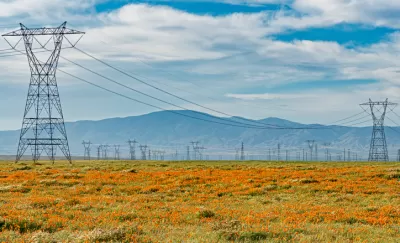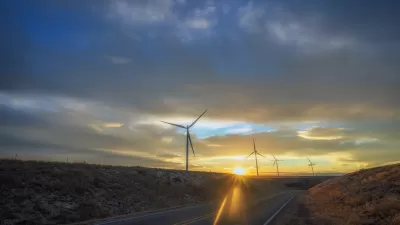The years-long permitting process for new transmission lines is slowing the state’s shift to clean energy.

In an article in Governing, Ari Plachta argues that the complex permitting process for building new power lines in California is holding back the state’s clean energy sector.
Plachta explains the growing need for electricity in California, where “climate change is driving an increased demand for electricity, due to extreme weather and electrification of homes and cars” and peak demand is expected to double by 2040. “Without enough power lines, California will fall short of its goal to supply 100 percent clean energy by 2045.”
Several agencies estimate that the state’s grid will need to roughly triple its transmission capacity by 2050, but adding capacity is increasingly costly and time-consuming. “[I]n 2022, a long-distance transmission line faces a six-to-ten-year journey through California’s regulatory system.” Meanwhile, transmission lines can cost millions of dollars per mile, “making cost a source of contention between renewable energy developers and utilities.”
Projects are also sometimes delayed by community opposition, Plachta adds. “Whether it’s from suburban homeowners concerned about property values or indigenous tribes protecting cultural resources, advocates hope to find a public that’s more receptive to clean energy infrastructure development.” But industry experts say major reforms are needed to meet the state’s clean energy goals and the growing demand for electricity.
FULL STORY: It Takes too Long to Build New Power Lines in California

Alabama: Trump Terminates Settlements for Black Communities Harmed By Raw Sewage
Trump deemed the landmark civil rights agreement “illegal DEI and environmental justice policy.”

Study: Maui’s Plan to Convert Vacation Rentals to Long-Term Housing Could Cause Nearly $1 Billion Economic Loss
The plan would reduce visitor accommodation by 25% resulting in 1,900 jobs lost.

Planetizen Federal Action Tracker
A weekly monitor of how Trump’s orders and actions are impacting planners and planning in America.

Study Links Covid and Poor Driving
The effects of the virus, including ‘brain fog,’ can make driving more difficult and dangerous.

Waymo Gets Permission to Map SF’s Market Street
If allowed to operate on the traffic-restricted street, Waymo’s autonomous taxis would have a leg up over ride-hailing competitors — and counter the city’s efforts to grow bike and pedestrian on the thoroughfare.

Parklet Symposium Highlights the Success of Shared Spaces
Parklets got a boost during the Covid-19 pandemic, when the concept was translated to outdoor dining programs that offered restaurants a lifeline during the shutdown.
Urban Design for Planners 1: Software Tools
This six-course series explores essential urban design concepts using open source software and equips planners with the tools they need to participate fully in the urban design process.
Planning for Universal Design
Learn the tools for implementing Universal Design in planning regulations.
Caltrans
Smith Gee Studio
Institute for Housing and Urban Development Studies (IHS)
City of Grandview
Harvard GSD Executive Education
Toledo-Lucas County Plan Commissions
Salt Lake City
NYU Wagner Graduate School of Public Service





























